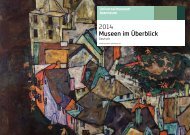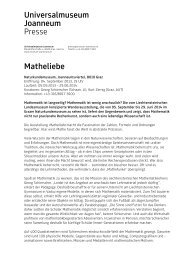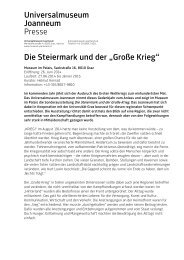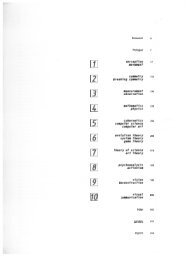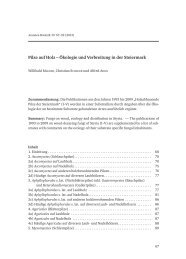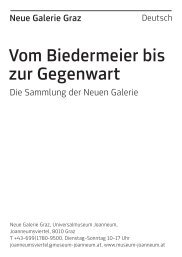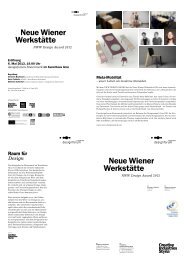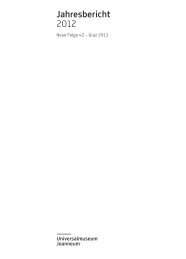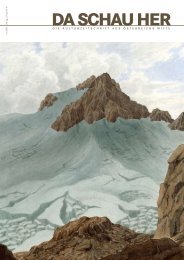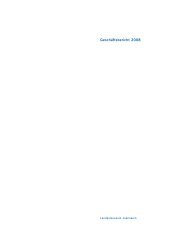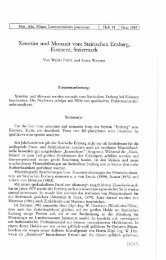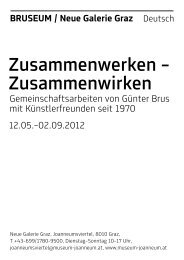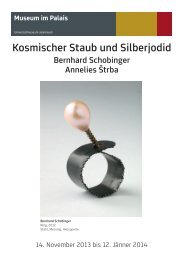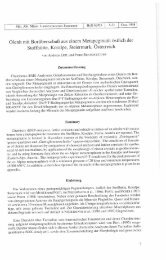Diana Thater gorillagorillagorilla - Universalmuseum Joanneum
Diana Thater gorillagorillagorilla - Universalmuseum Joanneum
Diana Thater gorillagorillagorilla - Universalmuseum Joanneum
Erfolgreiche ePaper selbst erstellen
Machen Sie aus Ihren PDF Publikationen ein blätterbares Flipbook mit unserer einzigartigen Google optimierten e-Paper Software.
<strong>Diana</strong> <strong>Thater</strong>,<br />
Untitled Videowall, 2008<br />
Installationsansicht, 1301PE,<br />
Los Angeles<br />
<strong>Diana</strong> <strong>Thater</strong>,<br />
Untitled Videowall, 2008<br />
Installation view, 1301PE,<br />
Los Angeles<br />
Das Museum ermöglicht einen Blick auf die Welt, indem<br />
es Teil der Welt ist. Von seinen Anfängen an war es ein Ort<br />
des Staunens und der Forschung, der Reflexion und der<br />
Bewertung. Gerade im Museum geschah dies immer im<br />
Wechselspiel von Wissen und Ästhetik. Die ebenso produk -<br />
tive wie komplexe Beziehung zwischen Kunst und Wissen -<br />
schaft und ihre Interaktion ist im Zuge der Spezialisierung<br />
der Moderne zeitweise auf der Strecke geblieben und rückt<br />
aufgrund eines neuen Interesses an der Überschreitung von<br />
Grenzen wieder in den Vordergrund.<br />
Im Landesmuseum <strong>Joanneum</strong> versuchen wir, dem heute noch<br />
vorhandenen Charakter des <strong>Universalmuseum</strong>s gerecht zu<br />
werden und der Interdisziplinarität wieder stärkere Bedeutung<br />
zu geben. So war die mit der Einladung von <strong>Diana</strong> <strong>Thater</strong><br />
verbundene Aufforderung des Londoner Museum of Natural<br />
History zu einer Kooperation natürlich höchst will kommen.<br />
Die gemeinsam produzierte Installation von <strong>Diana</strong> <strong>Thater</strong><br />
wird sowohl hier im Kunsthaus Graz als auch im Londoner<br />
Museum im Rahmen des Darwin-Jahres gezeigt.<br />
Der Künstlerin <strong>Diana</strong> <strong>Thater</strong> gelingt es wie kaum jemand<br />
anderem zuvor, bewegte Bilder in den Raum zu setzen, ohne<br />
in die Fallen eines vordergründigen Illusionismus zu tappen.<br />
Das ist für uns im Kunsthaus Graz natürlich besonders in<br />
Hinblick auf die komplexe Architektur des Hauses interessant,<br />
im Speziellen des großen oberen Saals, des Space01.<br />
Es ist auch ein großes Verdienst von <strong>Thater</strong>, in ihren zumeist<br />
skulptural zu verstehenden Installationen den Raum der Bilder<br />
maßgeblich erweitert zu haben. Erfolgreich spannt sie immer<br />
neue Räume auf, Räume, die real vorhanden und metaphorisch<br />
lesbar sind, Räume, die sich auf das Wissen wie auch auf<br />
Wahrnehmung und Empfindung beziehen.<br />
Einer ihrer großen Themenkreise ist die Biologie, der Umgang<br />
mit den Tieren und der Natur. Dabei stellt sie Fragen in vielerlei<br />
Richtungen. Sie setzt zu einem Blick auf die Phänomene an,<br />
der nichts von der Sentimentalität spüren lässt, die solche<br />
Fragen oft umgibt. Sie versteht es, in ihrer künstlerischen Arbeit<br />
neueste Erkenntnisse der Naturwissenschaft und Philosophie<br />
aufzugreifen und in dieser Verbindung einen Denkraum zu<br />
schaffen, wie ein heutiges Kontinuum des Wissens aussehen<br />
könnte. Gerade in den Wissenschaften vom Leben war Bildlichkeit<br />
immer von größter Bedeutung, wie wir in letzter Zeit<br />
besonders eindrucksvoll am Beispiel Darwins durch Julia Voss’<br />
Buch zur Bedeutung von Bildern und deren Verwendung im<br />
Peter Pakesch 6 7<br />
Museums provide a view of the world and yet are part<br />
of that world. They were from the first places for that<br />
“wow!” experience, but also places of research, reflection<br />
and evaluation. In museums, moreover, there was<br />
always a trade-off between knowledge and aesthetics.<br />
Yet, due to increasing specialisation in the modern era,<br />
the complex and yet productive relationship (and interaction)<br />
between art and science has from time to time<br />
retreated into the background. Because of the new interest<br />
in crossover, it has now returned to the spotlight.<br />
At the Landesmuseum <strong>Joanneum</strong>, we try to do justice<br />
to that still surviving aspect of the universal museum<br />
by putting more emphasis on inter-disciplinarity. The<br />
offer of collaboration by the Natural History Museum in<br />
London in conjunction with an invitation of <strong>Diana</strong> <strong>Thater</strong><br />
was therefore highly welcome. The jointly produced<br />
installation by <strong>Diana</strong> <strong>Thater</strong> will be shown both here at<br />
the Kunsthaus Graz and in the Natural History Museum<br />
as part of the bicentenary Darwin celebrations.<br />
<strong>Diana</strong> <strong>Thater</strong> manages better than almost any artist<br />
before her to put moving pictures into a room without<br />
falling into the trap of a superficial illusionism. That is<br />
particularly interesting for us here at the Kunsthaus<br />
Graz given the complex architecture of the building,<br />
no tably of the large Space01 room at the top. It is es -<br />
pecially to <strong>Thater</strong>’s credit that her installations – generally<br />
of a sculptural nature – have considerably extended<br />
the scope of images. She is constantly expanding into<br />
new spaces, creating latitudes that can be interpreted<br />
as both really existent and metaphorical – spaces that<br />
relate to our knowledge, and also perception and feeling.<br />
One of her great thematic areas is biology, and<br />
how we relate to animals and nature. Here she raises<br />
a wide range of issues and approaches the phenomena<br />
with no trace of the sentimentality that often<br />
goes with such matters. She is well abreast enough<br />
to incorporate the latest scientific discoveries and<br />
philosophy in her work and trigger off trains of thought<br />
in this connection as to what a continuum of knowledge<br />
might look like today. Visual representation<br />
was always important particularly in the life sciences,<br />
as was recently demonstrated most impressively<br />
by Julia Voss in her book on Darwin and his use of



